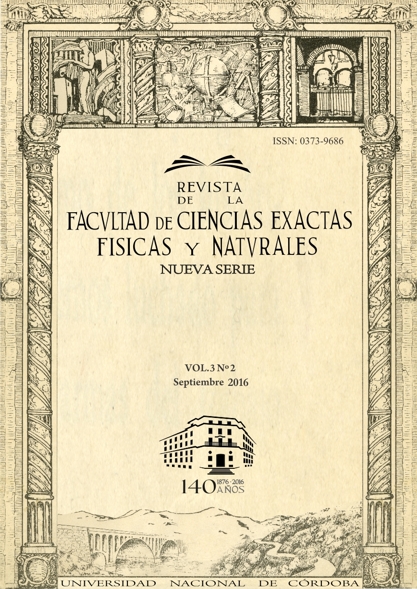GLOrbit: A 3D satellite orbit propagator for network topology analysis
Palabras clave:
Redes de Satélites, Redes Tolerante a Demoras y Disrupciones, Protocolos de ComunicacionesResumen
Los protocolos de redes tradicionales fueron desarrollados para redes terrestres, caracterizadas por topologías altamente estáticas. En este escenario, los errores de enlace aleatorios han sido el cambio más demandante que una configuración de red podía enfrentar. Por otro lado, los protocolos de redes móviles se ocupan de topologías dinámicas pero asumen trayectorias desconocidas y muy alta conectividad. Ninguna de ambas se aplica al paradigma para las redes de constelaciones satelitales donde su naturaleza orbital describe topologías temporalmente variables pero altamente predecibles. Para estudiar este tipo de redes tolerantes a demoras, proponemos GLOrbit; una herramienta de análisis de topologías y redes de satélites, capaz de propagar nodos espaciales en el tiempo, en un ambiente visual 3D mientras registra la topología en diferentes formatos para estudios analíticos posteriores. Para esto implementamos el algoritmo de propagación SGP4, evaluadores de enlace entre nodos, y un motor gráfico de OpenGL. Esto permite obtener salidas precisas para graficar la red satelital y el análisis físico mientras se va ganando intuición visual para diferentes configuraciones orbitales. Se demuestran las capacidades de la herramienta con un primer trabajo de análisis con GLOrbit de tres topologías de orbitas bajas representativas. Escenarios lineales, transversales y diferentes escenarios de altitud son estudiados concluyendo que los lineales poseen una gran fortaleza en los enlaces inter-satelitales, mientras que los segundos en los contactos tierra-espacio. Finalmente, pero no por ello menos importante, debido a que los gráficos tradicionales representan redes estáticas, una novedosa estructura gráfica para topologías evolutivas temporalmente, es presentada como un resultado para el diseño topológico de redes tolerantes a demoras predecibles y sus estrategias de asignación de enlaces.Descargas
Referencias
[1] Interplanetary Internet Special Interest Group (IPNSIG): http://www.ipnsig.org
[2] M. Segal; K. Akeley. The OpenGL Graphics System: (Version 1.4) http://www.opengl.org/registry/doc/glspec14.pdf 1992-2002 Silicon Graphics, Inc.
[3] A. Pederson et al. "Visualization of Astrodynamics and Attitude Concepts for Education", AAS03-502, Analytical Graphics, Inc.
[4] Hoots, Felix R.; Ronald L. Roehrich (31 December 1988). ``Models for Propagation of NORAD Element Sets''. United States Department of Defense Spacetrack Report. Retrieved 16 June 2010.
[5] D. Vallado. ``Fundamentals of Astrodynamics and Applications'', Third Edition, Space Technology library. October 2011.
[6] Celestrak. url: http://www.celestrak.com/
[7] AGI - Stellite Toolkit. url: www.agi.com/stk
[8] ESA's Space Trajectory Analysis Tool (STA) 2.0rc1. url: http://sourceforge.net/projects/sta/
[9] General Mission Analysis Tool (GMAT) R2012a-Beta. url: http://gmat.gsfc.nasa.gov
[10] NOVA: Satellite Tracking Software Real Time Tracking of an Unlimited Number of Satellites. url: http://www.nlsa.com
[11] Visualyse Professional v7. url: http://www.transfinite.com/
[12] SaVi - Satellite Constellation Visualisation v1.4.5. url: http://savi.sourceforge.net/
[13] Geomview 1.9.4. url: http://www.geomview.org/
[14] H. S. Chang et al. ``Topological Design and Routing for LEO Satellite Networks'' Technical Report SNU-CE-AN-96-001, Department of Computer Engineering, Seoul National University, June 1996.
[15] Noakes, M.D. et al. ``An adaptive link assignment algorithm for dynamically changing topologies'' IEEE Transactions on Communications, May 1993.
[16] The Khronos Group - Connecting Software to Silicon – url: http://www.khronos.org
[17] R. J. Leopold, A. Miller, and J. L. Grubb, ``The Iridium System: A New Paradigm in Personal Communications'' in Appl. Microwaves & Wireless, pp. 68-78, Fall 1993
[18] Free-Glut: The Free OpenGL Utility Toolkit by Mark Kilgard. url: http://freeglut.sourceforge.net/
[19] M. Ikits, M. Magallon. ``GLEW: The OpenGL Extension Wrangler Library''. url: http://glew.sourceforge.net/
[20] Norman Chin et al. ``The OpenGL Graphics System Utility Library'' (Version 1.3), 1998. url: http://www.opengl.org/registry/doc/glu1.3.pdf
[21] Simple OpenGL Image Library, 2008. url: http://www.lonesock.net/soil.html
[22] Lane, M.H. and Hoots, F.R., ``General Perturbations Theories Derived from the 1965 Lane Drag Theory'', Project Space Track Report No. 2, December 1979, Aerospace Defense Command, Peterson AFB, CO.
[23] David A. Vallado, et al. ``Revisiting Spacetrack Report #3'', AIAA 2006-6753 , Center for Space Standards and Innovation, Colorado Springs, Colorado, 80920.
[24] The afternoon constellation (A-Train). url: http://atrain.nasa.gov/, NASA, 2012
[25] Edward J. Taylor. ``Orbit Theory and Applications'', June 1991. url: http://www.cdeagle.com/pdf/taylor.pdf
[26] Walter Hohmann, The Attainability of Heavenly Bodies (Washington: NASA Technical Translation F-44, 1960)
[27] Emden R. Gansner, et al, “A Technique for Drawing Directed Graphs'', 1993, AT&T Bell Laboratories, Murray Hill, New Jersey 07974.
[28] J. Fraire and J. Finochietto, “Design challenges in contact plans for disruption-tolerant satellite networks,” Communications Magazine, IEEE, vol. 53, no. 5, pp. 163–169, May 2015.
Descargas
Publicado
Número
Sección
Licencia
Se permite cualquier explotación de la obra, incluyendo la explotación con fines comerciales y la creación de obras derivadas, la distribución de las cuales también está permitida sin ninguna restricción.



